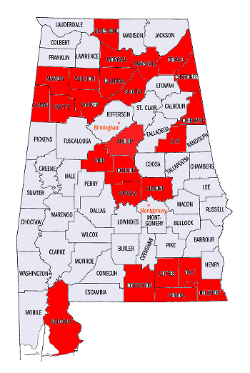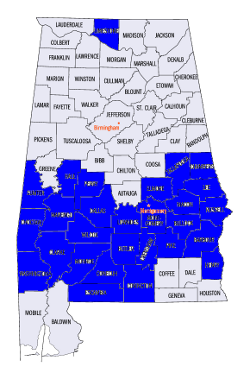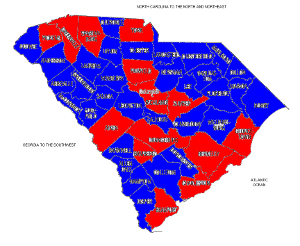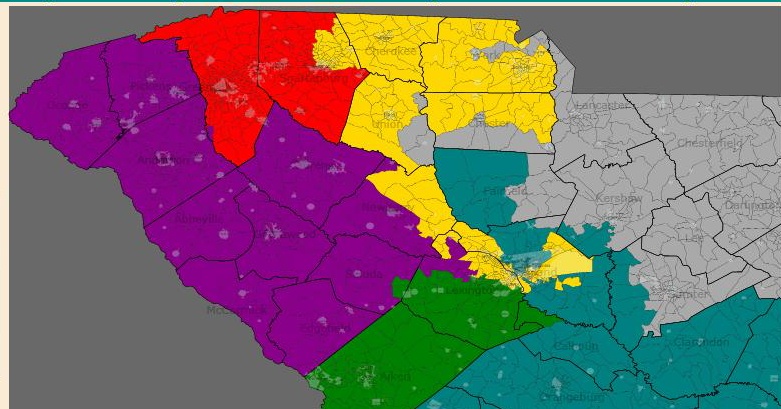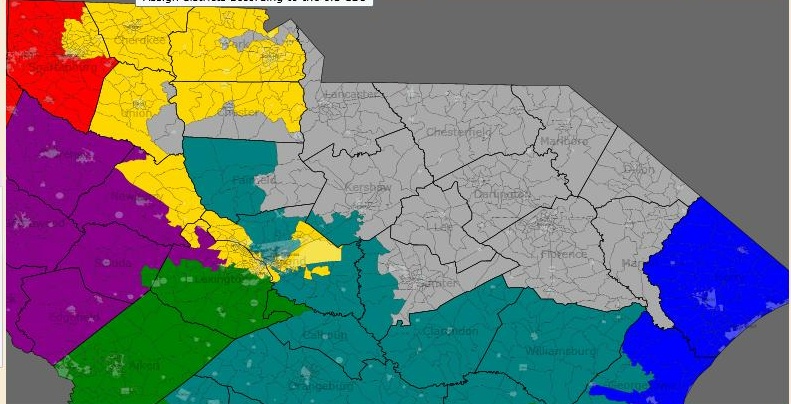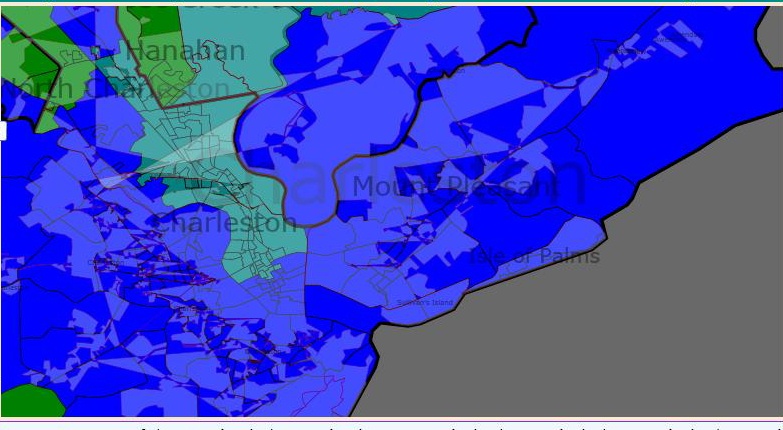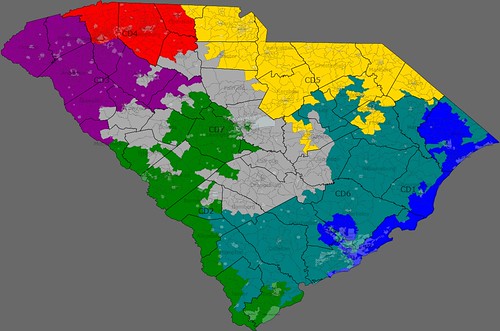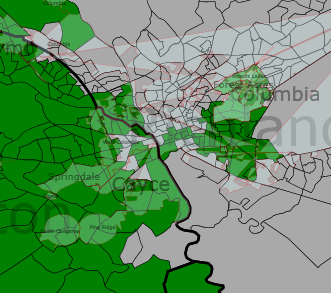Here is Episode 7 in my redistricting series. Episode 7 was meant to be Arizona & New York, but with NY-20 undecided and likely to be for a time, I thought it was time to press ahead with other states I’ve drawn. So here we have it: the Land of Lincoln and the founding state of the Confederacy, wrapped together at last in one diary!
Previously covered:
Diary 1: Massachusetts and Texas
Diary 2: Michigan and Nevada
Diary 3: Iowa and Ohio
Diary 4: Georgia and New Jersey
Diary 5: Florida and Louisiana
Diary 6: Pennsylvania and Utah
Jump below to read what I was doing at 3:00 AM last night!
Illinois
First, the basics about Illinois: the Democrats control the redistricting trifecta and, I believe, still will after 2010. The state should lose a seat for a total House delegation of 18; though the current slowdown in migration may just save the state its 19th spot, most number-crunchers believe Illinois will just miss out on holding steady.
With Democrats in control of the process, I got to draw my first bona fide hypothetical Democratic gerrymander for 2011. The first key was to ensure that the lost seat was a Republican one, and since this decade, it looks like Chicago will suffer the loss rather than downstate, I chose the ever-frustrating Mark Kirk of Highland Park. His district is cracked in this map between the new seats of Melissa Bean (D-Barrington) and Jan Schakowsky (D-Evanston), both of which would decidedly favor Democratic incumbents. Kirk’s home would be in Schakowsky’s district, FWIW.
Knowing the dangers of overreaching or “getting too greedy” in gerrymandering, I don’t believe Democrats will or should go after every last GOP seat in metro Chicago, particularly with the need to protect Bean, Bill Foster (D-Geneva), and Debbie Halvorson (D-Crete). So I pushed Foster and Halvorson into Cook County and made their districts more compact/urban/suburban and less sprawling. While Obama’s popularity in his home state makes it very easy to put GOP incumbents in “Obama districts”, that kind of thinking all too easily leads to spreading Dem votes thinly and often backfires.
From this map, Democrats can expect a 12-6 majority, with an outside shot at 13-5. Which district did I soften up? Actually, Aaron Schock’s downstate…making his district more competitive was fairly easy compared to the tortuous work that would be required to dislodge Peter Roskam while protecting Foster, Halvorson, and Bean.
Voilà:

By the way, don’t pay too much attention to my boundaries in the urban Chicago districts; the granularity at this level is absurd, and I drew these boundaries crudely, since I’m using Paint and a calculator rather than any real redistricting technology.
District 1 – Bobby Rush (D-Chicago) — VRA black-majority, South Side.
District 2 – Jesse Jackson, Jr. (D-Chicago) — VRA black-majority, South Side.
District 3 – Dan Lipinski (D-Western Springs) — entirely within Cook County, working- and middle-class close-in Chicago suburbs.
District 4 – Luis Gutierrez (D-Chicago) — VRA Hispanic-majority, takes in the heavily Latino areas of Chicago, Cicero, etc.
District 5 – Vacant — the North Side seat should be rock-solid for Quigley or any other Democrat.
District 6 – Peter Roskam (R-Wheaton) — entirely within DuPage County, Obama-supporting but traditionally Republican. Believe me, as one of Tammy Duckworth’s most active volunteers in 2006, I would have loved to draw Roskam a district he can’t win, but couldn’t find a way to do so without endangering Foster and Halvorson, and in partisan gerrymanders, safety comes first.
District 7 – Danny Davis (D-Chicago) — VRA black-majority seat: downtown Chicago, Oak Park, Maywood, etc.
District 8 – Melissa Bean (D-Barrington) — dominated by its 64% portion of Lake County, but takes in 5% of Cook to help Bean a bit.
District 9 – Jan Schakowsky (D-Evanston) vs. Mark Kirk (R-Highland Park) — the remaining 36% of Lake (including Kirk’s home base) and 9% of Cook (which dominates population-wise). With Schakowsky’s North Shore base intact and stronger numerically than Kirk’s turf in southern Lake County, I’d feel good about our chances in a match-up.
District 10 – Debbie Halvorson (D-Crete) — all of Will and a tiny, heavily black South Side portion of Cook is meant to protect Halvorson by allowing her to shed all that GOP-leaning exurban country to the west.
District 11 – Jerry Costello (D-Belleville) — the most Democratic downstate district, centered on metropolitan St. Louis and other traditionally Democratic areas like Carbondale. I caused a little mischief by putting John Shimkus’ home in this district, though I think he’d do well to move to the 18th since Costello would be a solid fit here.
District 12 – Judy Biggert (R-Hinsdale) — this monster reminds me of Lamar Smith’s 1990s district in Texas, designed to grab every possible Republican voter for the sake of Democratic incumbents in the area. This comprises the southern 23% of DuPage, 6% of Kane, 62% of Kankakee, and exurban counties DeKalb, Grundy, Kendall, LaSalle, and Lee, dramatically reshaping the district to remove GOP areas that would otherwise be represented by Foster and Halvorson. In a way, having one sprawling seat like this makes more sense than the previous incarnation that had Foster and Halvorson writhing all over the place in positively serpentine fashion.
District 13 – Bill Foster (D-Geneva) — 94% of Kane (Foster’s base) and 5% of Cook (to push his district bluer) = the likelihood of holding this seat when Foster retires.
District 14 – Timothy Johnson (R-Urbana) — other than Johnson’s native Champaign County, this could be the state’s most Republican district; if not, it’s nearly as much so as Shimkus’. Why make Johnson so overwhelmingly safe? Well, I was interested in weakening Schock a bit (or a lot), and it seemed logical to pack Republicans into Johnson’s district due to pure geography. Also, if I was going to help solidify a GOP seat, why not reward Johnson’s relative sanity compared to people like Schock?
District 15 – Donald Manzullo (R-Egan) — due to growth up there, Manzullo’s district becomes more compact and probably remains Obama-supporting, though I suspect it tilts quite Republican in most years.
District 16 – Phil Hare (D-Rock Island) — I’ve always disliked the current 17th and its embarrassingly gerrymandered lines, so sought to clean it up without hurting Hare. By losing its southern “Springfield leg”, it took in some normally GOP-leaning counties in the northwest, though the Obama numbers are probably better than before due to Obama’s superb performance in even exurban and rural northern Illinois. This is now something of a north-south Mississippi River seat, but should still favor a Moline-area Democrat.
District 17 – Aaron Schock (R-Peoria) — To hurt one GOP incumbent without rendering the must-protect Chicago-area Democrats, Schock was an obvious choice: he’s young, new, and rather obnoxious. This district still leans Republican, but is a heck of a lot more moderate, anchored by the Peoria area, Springfield, and Bloomington-Normal, with a small sliver of Champaign County. This district would have voted for Obama, and Schock would be vulnerable to a strong challenge from a conservative Democrat. Without hurting Hare and Costello, that’s the best I could do.
District 18 – John Shimkus (R-Collinsville) would run here — As I said, his home would be represented by Costello, but he’d choose to run here, a very strong GOP seat with only traces of moderation (Springfield and Decatur, mostly).
Overall, I have mixed feelings about this map. I think I handled the Chicago area fairly well (and after all, I did live there for four years), not overextending Democratic strength by getting greedy about Roskam or Biggert. I’m decently happy with my downstate reconfiguration, but am curious if Hare would still be safe enough. Obviously no Democratic gerrymander would result in a much-weakened seat for Hare, so perhaps I should have preserved Springfield and Decatur for him (then again, northwest Illinois needs to go somewhere!).
Anyway, an average year would result in a 12-6 split under this map, and a good year could see 13-5 should Schock fall. What about a bad year? Do you think Hare, Foster, Bean, and Halvorson would all be fine in a difficult year? Input needed!
South Carolina
And now for something completely different: this Deep Southern state experienced the highest domestic migration rate in the nation between 2007 and 2008. Monopolized by Republicans, I sought to draw a GOP gerrymander here that would protect the four current Republican seats and add a new one, while weakening John Spratt (D-York) if at all possible.
Knowing how Republicans love to pack minority votes, I drew Majority Whip Jim Clyburn the most heavily African-American district imaginable. It looks like a crab, actually, and yes, it’s exactly the kind of racial gerrymander Republicans would draw (interesting that we saw so many Democratic maps in the South that aimed for maximizing black representation thrown out by the courts as “racial gerrymanders” in the 1990s, but recent Republican racial packing in states like Florida and Texas has gone unnoticed).
One nit: with the state’s black population around 30%, the Justice Department might want a map that creates two VRA black-majority seats (two seats out of seven = 29%). That would involve diluting Clyburn’s seat a little and trading some turf with Spratt, rendering Spratt’s district a lot safer.
But I presumed only one VRA seat, so with that in mind:

District 1 – Henry Brown (R-Hanahan) — More compact and less coastal than Brown’s current district, it loses Charleston to aid him and prevent a future close call like he faced in 2008 from Linda Ketner.
District 2 – Joe Wilson (R-Springdale) — Heavily Republican, takes the white areas around Columbia from Clyburn, acting as a sort of Alabama 4th to Clyburn’s Alabama 7th.
District 3 – Gresham Barrett (R-Westminster) — also heavily Republican, with the cleanest lines I could possibly draw.
District 4 – Bob Inglis (R-Travelers Rest) — due to growth in the Greenville/Spartanburg area, this district is getting positively small!
District 5 – John Spratt (D-York) — while carving out GOP turf for Brown, Inglis, and Barrett, I tried my best to keep Spratt’s seat potentially GOP-friendly should he retire. But if the Justice Department demands two VRA seats, this could turn out very differently, with Spratt getting a solid Dem district for the first time in recent memory.
District 6 – Jim Clyburn (D-Columbia) — dominated by Columbia, taking every possible black-majority county. Truly a lawsuit-worthy gerrymander, but Republicans seem to get away with those (look at how the courts have reacted to Corrine Brown’s FL-03 versus their decisions in the 1990s about Cynthia McKinney’s GA-11, Cleo Fields’ LA-04, and Mel Watt’s NC-12).
The new District 7 – Designed for a Charleston/Beaufort County Republican due to growth along the coast. This seat would be GOP-friendly but trending Dem long-term and might need to be reconfigured in 2021 to stave off Democratic gains.
Overall, Republicans could hope for a 6-1 majority when Spratt retires, but in the mean time would have to settle for 5-2. When Spratt does go, the coast may be blue enough for a Democrat to win either District 1 or District 7. And if the state creates a new VRA seat, Republicans will make it Spratt’s to avoid ceding more territory. I do wonder how that map would look…
EDIT: It was brought to my attention that the current 5th is as heavily Democratic as any VRA district, and is essentially wasting votes. So I adjusted the lines a bit based on someone’s suggestion to create two skinny DuPage-Cook mix districts; the 5th would be Quigley land, and the 6th would be a more Democratic seat for Roskam. Thus this map could easily produce 13-5, not counting Schock.
Someone else suggested softening up Lipinski, but since that district is already somewhat socially conservative, and doesn’t link easily with Roskam’s, I chose to leave it alone. The 5th is needlessly packed in the current map, while the 3rd is significantly less solid. Here’s the adjusted map:

Which one do you folks like better? In this version, Roskam’s district has about 415K from DuPage and 301K from Cook, while Quigley’s district has precisely reversed numbers.
